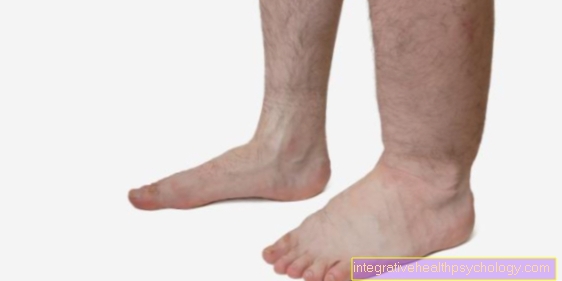Lower leg prosthesis
What is a lower leg prosthesis?
A lower leg prosthesis is an artificial lower leg that is used after the lower leg has been lost through an accident or a lower leg amputation. A lower leg prosthesis is one of the so-called exoprostheses, as it is attached outside the body (in contrast to endoprostheses, such as an artificial heart valve).
A lower leg prosthesis is placed under the knee. The prosthesis is intended to replace the function of the missing body part as much as possible and enables those affected to walk again without crutches.

Indications for a lower leg prosthesis
A lower leg prosthesis is used after lower leg amputations. A lower leg amputation may be necessary if the leg is irreparably damaged by a disease (e.g. peripheral arterial occlusive disease PAD), a wound or an accident and an amputation located further peripherally, e.g. is not possible at the ankle.
During the operation, the surgeon tries to create the most resilient stump possible with a freely movable knee joint.
After the wound has healed, the muscles of the remaining leg are built up using physiotherapy and what is known as an initial prosthesis is made later. The final prosthesis (definitive prosthesis) is only made after about six months, as the residual limb takes several months to completely heal and take on its final shape.
The definitive prosthesis is much more stable and is also cosmetically disguised so that it adapts to the patient's leg stump. The lower leg prosthesis is made individually for each patient and tailored to their needs.
For example, it is possible that the patient can drive, jog or swim with the prosthesis.
Learn more about: Peripheral arterial disease
What types of lower leg prostheses are there?
A distinction is made between several types of lower leg prostheses. Depending on how the prosthesis is attached to the leg stump, a distinction is made between those with a vacuum system, with a locking mechanism or with a two-shaft system.
In the case of a prosthesis with a vacuum system, the artificial lower leg is attached to the residual limb using negative pressure (either active or passive). The prosthesis can also be attached by means of a locking mechanism, a distinction being made between the so-called shuttle lock and clutch lock technology.
Lower leg prostheses can also be classified based on their shaft system. The prosthesis socket connects the leg stump with the lower leg prosthesis and distributes the body weight evenly.
The shaft is attached either via an upper sleeve, a clasp technique (PTB prosthesis = patella tendon bearing or PTS prosthesis = prosthesis tibial supracondylienne) or a so-called condyle bedding (KBM prosthesis = condyle bedding Münster).
Furthermore, a distinction is made between the initial prosthesis, which is used for initial treatment and learning how to use a prosthesis, and the definitive prosthesis, which is made individually for each patient after about six months.
Finally, the classification can also be based on the type of prosthesis. In addition to the everyday prosthesis, which patients wear at home, at work and in their free time, there are also special sports or bath prostheses.
These prostheses must be waterproof or suitable for various sports such as skiing, jogging or riding. Under special circumstances it may only be necessary to make your own prosthesis for the workplace.
So-called phantom pain can occur after an amputation. It can often confuse, because it describes pain in a part of the body that is no longer there, here it is e.g. in the lower leg. For detailed information, see: Phantom pain
What is a lower leg prosthesis with a femoral stem?
In addition to a simple short lower leg prosthesis, there are also lower leg prostheses with a thigh shaft (also called upper sleeve or upper shaft). This is a prosthesis that is also equipped with a removable thigh shaft.
The upper sleeve usually consists of a leather cuff that can be attached to the remaining thigh with laces, straps or a Velcro fastener.
The upper sleeve primarily serves to relieve the knee joint and is used for knee problems or extremely short leg stumps. This type of artificial lower leg is also used as a sports prosthesis.
The knee is stabilized by the thigh sleeve, which means that increased varus or valgus stress (opening the knee joint outwards or inwards) on the residual limb can be avoided.
Is there a waterproof lower leg prosthesis?
There are also waterproof lower leg prostheses with which those affected can bathe or swim in salt and fresh water. The prostheses can be cosmetically disguised in such a way that the lower leg prosthesis looks very natural and cannot be recognized as such at first glance.
According to the law, every person who has had an amputation on their leg is entitled to a waterproof bath prosthesis in addition to an everyday prosthesis.
How is a lower leg prosthesis constructed?
A lower leg prosthesis is made up of several parts. The special structure is individually adapted to the patient and his needs. For example, people who are only in the house and cover short distances have different lower leg prostheses than a person who moves freely inside and outside.
In general, a prosthesis consists of a shaft, a connection unit and a prosthetic foot. A cosmetic cladding of the prosthesis to adapt to the received case is also possible.
The prosthesis is connected to the leg stump via the shaft directly below the knee joint. The prosthesis socket surrounds the residual limb and distributes the body weight evenly. The socket is attached to the stump using various locking techniques (vacuum, shuttle lock, clutch lock).
The shaft must be comfortable to wear and must not press, which is why it is optimally adapted to the shape of the leg stump for each patient.
The patient with the lower leg prosthesis is in contact with the floor via the prosthetic foot. There are many different models of prosthetic feet selected according to the patient's degree of mobility.
What does a lower leg prosthesis cost?
The cost of making a lower leg prosthesis is between 6,000 and 20,000 euros. The big price difference results from the fact that each prosthesis is individually adapted to the patient and his needs.
Most hospitals work with orthopedic technicians who automatically approach the patient after an amputation and advise him. The needs of the patient are discussed in a consultation. The price of the lower leg prosthesis depends on the patient's degree of mobility and what activities they want to do.
According to the law, every patient who has undergone an amputation is entitled to a prosthesis. The health insurance companies cover the costs.
What does the health insurance fund?
The health insurance company normally pays the full cost of a lower leg prosthesis. Anyone who has had part of their lower extremities amputated is also entitled to a waterproof lower leg prosthesis (bath prosthesis).
The costs for replacement prostheses, which patients need when the everyday prosthesis has to be repaired or cannot be used for other reasons, are usually not paid by the statutory health insurance companies. However, exceptions are possible in individual cases.
How do I put on a lower leg prosthesis correctly?
In the course of the rehabilitation treatment, those affected learn, together with the responsible orthopedic technician, how to handle their lower leg prosthesis and how to put the prosthesis on correctly. In general, how to put it on correctly depends on what type of prosthesis it is.
Especially prostheses with a vacuum system can be put on quickly and easily. When putting it on, it must be ensured that the socket is correctly connected to the leg stump so that there is a secure connection between the person and the prosthesis.
In most cases, the creation of a so-called liner has become established. This is a type of silicone stocking that is pulled over the leg stump before the prosthesis can be put on. The liner prevents pressure points from forming and ensures that the prosthesis socket is held firmly on the leg.
Immediately after the amputation in the period of first aid, the patient must practice putting on the prosthesis together with the orthopedic technician in charge. Over time, however, those affected quickly learn to put on the lower leg replacement and can shape their lives independently.
The next article could also be of interest to you: Prosthesis supply
Can you drive a car with a lower leg prosthesis?
Even with a lower leg prosthesis, it is possible for patients to drive a car. Depending on which side the amputation was carried out, the car must be adapted accordingly.
People who wear a prosthetic leg on the left can simply drive with an automatic system, while those on the right have the option of converting the car specifically. The accelerator pedal is moved to the left with automatic gear shifting.
An amputation is therefore no reason why people with a prosthetic leg can no longer drive a car. The attending physician can refer the patient to agencies (e.g. driving schools, TÜV or social services) that provide help and inform the person concerned about the possibilities.





























